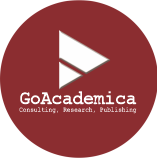UPAYA MENINGKATKAN KEMAMPUAN BAHASA DAN KOMPETENSI KOMUNIKASI ANTAR PRIBADI DALAM MENINGKATKAN PROFESIONALISME KARYAWAN
DOI:
https://doi.org/10.15575/jim.v1i1.8285Keywords:
Pelatihan Perusahaan, Bahasa, Komunikasi Antarpribadi, Kinerja.Abstract
Perusahaan yang memahami hubungan antara keterlibatan karyawan dan kesuksesan bisnis akan menemukan cara untuk mendorong dan memfasilitasi kesejahteraan emosional pekerja. Salah satu cara untuk mendorong keterlibatan karyawan adalah dengan memberikan pelatihan keterampilan bahasa dan komunikasi antarpribadi. Penelitian ini bertujuan untuk menganalisis apa yang dilakukan oleh perusahaan yang berbasis di Amerika Serikat untuk mencapai tujuan melalui pelatihan keterampilan bahasa dan komunikasi pribadi antara karyawan perusahaan. Metode penelitian ini menggunakan metode kualitatif. Tiga implikasi nyata dari penelitian ini relevan untuk pendidikan bisnis profesional: (a) contoh analisis bisnis yang sebenarnya kegiatan kelas yang berharga, (2) siswa perlu mengenali peran interaksi tempat kerja sehari-hari pada produktivitas dan kepuasan kerja, dan (3) perusahaan mendapat manfaat dari layanan konsultasi ahli di bidang bahasa dan komunikasi bisnis.
References
Amabile, T., & Kramer, S. (2011). The progress principle: Using small wins to ignite joy, engagement, and creativity at work. Harvard Business Press.
Barker, R. T., & Camarata, M. R. (1998). The role of communication in creating and maintaining a learning organization: Preconditions, indicators, and disciplines. The Journal of Business Communication (1973), 35(4), 443-467.
Wahyudi, S., Hasanudin, H., & Pangestutia, I. (2020). Asset allocation and strategies on investment portfolio performance: A study on the implementation of employee pension fund in Indonesia. Accounting, 6(5), 839-850.
Hasanudin, H., & Awaloedin, D. T. (2020). Pengaruh Current Ratio, Debt To Equity Ratio Dan Net Profit Margin Terhadap Return Saham Pada Perusahaan Jasa Sub Sektor Telekomunikasi Yang Terdaftar Di Bei Periode 2012-2018. JURNAL REKAYASA INFORMASI, 9(1), 6-19.
Adnyana, M., & Nurwulandari, A. (2020). Empirical examination of intersectoral linkages between tourism and regional economy by using the social accounting matrix.
Wahyudi, S., & Pangestuti, I. R. D. Managing The Pension Fund To Improve Portfolio Performance: An Empirical Study On Employer Pension Funds In Indonesia.
Hasanudin, H. (2021). The Effect of Inflation, Exchange, SBI Interest Rate and Dow Jones Index on JCI on IDX 2013–2018. Budapest International Research and Critics Institute (BIRCI-Journal): Humanities and Social Sciences, 4(2), 2063-2072.
Awaluddin, D. T., & Hasanudin, H. (2020). Tinjauan Analisis Kinerja Laporan Keuangan Pada Perusahaan Food & Beverage Yang Terdaftar Di Bei Pada Tahun 2013-2017. JURNAL REKAYASA INFORMASI, 9(1), 26-43.
Center for Professional Excellence at York College of Pennsylvania. (2012). Professionalism in the Workplace Study. Retrieved from http://www.ycp.edu/media/yorkwebsite/cpe/2012-Professionalism-in-the-Workplace-Study.pdf
Cross, R. L., Cross, R. L., & Parker, A. (2004). The hidden power of social networks: Understanding how work really gets done in organizations. Harvard Business Press.
Dyrud, M. A., & Worley, R. B. (1999). Focus on teaching: Using cases. Business Communication Quarterly, 62(4), 75-92.
Herzberg, F. (2008). One more time: How do you motivate employees?. Harvard Business Review Press.
Hopkins, C. D., Raymond, M. A., & Carlson, L. (2011). Educating students to give them a sustainable competitive advantage. Journal of Marketing Education, 33(3), 337-347.
Hynes, G., & Sigmar, L. (2009, April). The importance of business communication courses in employer hiring decisions. In First Annual General Business Conference Conference Proceedings (p. 193).
Ihani, W., Syofya, H., Sari, A. L., Mulawarman, W. G., & Sriyanto, S. (2020). The Role of the Creative Industry in Economic Development. Journal of Environmental Treatment Techniques, 8(1), 268-271.
Kirmer, R., & Sellers, J. A. (2009, February). How current is your BCOM course. In Association for Business Communication Southwestern US Annual Conference, Oklahoma City, OK.
Koc, E. W. (2011). Getting noticed, getting hired: Candidate attributes that recruiters seek. NACE Journal, 72(2), 14-19.
Lim, S., Cortina, L. M., & Magley, V. J. (2008). Personal and workgroup incivility: impact on work and health outcomes. Journal of applied psychology, 93(1), 95.
Mat, N. H. N., & Zabidi, Z. N. (2010). Professionalism in practices: a preliminary study on Malaysian public universities. International Journal of Business and Management, 5(8), 138.
Polk-Lepson Research Group. (2012). Professionalism in the workplace study. Center for Professional Excellence at York College of Pennsylvania, York, PA.
Reinsch Jr, N. L., Gardner, J. A., & Berland, P. S. (2011, October). Do good communicators get promoted? Maybe not. In Proceedings of the 76th annual convention of the Association for Business Communication. Retrieved from http://businesscommunication.org/wp-content/uploads/2011/10/2011-ABC-01-REINSCH.pdf.
Riketta, M. (2008). The causal relation between job attitudes and performance: a meta-analysis of panel studies. Journal of Applied Psychology, 93(2), 472.
Rogers, P. S., & Rymer, J. (1998). Business and management communication cases: Challenges and opportunities. Business Communication Quarterly, 61(1), 7-25.
Sandelands, L. E., & Boudens, C. J. (2000). Feeling at work. Emotion in organizations, 2, 46-63.
Tucker, M. L., Powell, K. S., & Dale Meyer, G. (1995). Qualitative research in business communication: A review and analysis. The Journal of Business Communication (1973), 32(4), 383-399.
Velasco, M. S. (2012). More than just good grades: candidates’ perceptions about the skills and attributes employers seek in new graduates. Journal of Business Economics and Management, 13(3), 499-517.
Downloads
Published
How to Cite
Issue
Section
Citation Check
License

This work is licensed under a Creative Commons Attribution-ShareAlike 4.0 International License.













